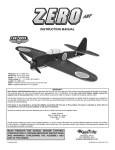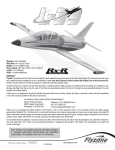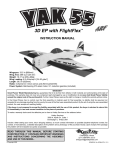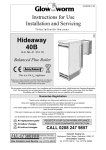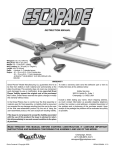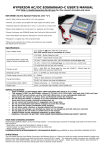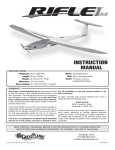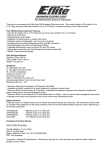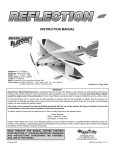Download ELECTRIC DUCTED FAN INSTRUCTION MANUAL
Transcript
™ ELECTRIC DUCTED FAN INSTRUCTION MANUAL Technical Data Fan Swept Area: 2.71 in2 [17.5cm2] Maximum rpm: 50,000 rpm Housing Inner Diameter: 2.14 in [54.5mm] Outer Diameter: 2.23 in [56mm] Complete Assembly Weight (no motor): 1.3 oz [37g] Welcome to the exciting world of Electric Ducted Fans (EDF)! The HyperFlow is a new EDF design created by Great Planes using the latest technology to fit onto smaller EDF airplanes. The HyperFlow was created with ease of use in mind, as well as superior performance using either a brushed or brushless motor. Great Planes offers several different motors that you can use to tailor the fan’s performance to meet your needs. This EDF can fly airplanes as small as 10oz [280g] to airplanes as big as 35oz [990g] depending on the chosen motor. Flying speeds have been measured to be from 55mph [88km/h] to 110mph [185km/h]. You can now fly modern jets and fly them in a realistic manner–fast. WARRANTY Great Planes® Model Manufacturing Co. guarantees this product to be free from defects in both material and workmanship at the date of purchase. This warranty does not cover any component parts damaged by use or modification. In no case shall Great Planes’ liability exceed the original cost of the purchased product. Further, Great Planes reserves the right to change or modify this warranty without notice. In that Great Planes has no control over the final assembly or material used for final assembly, no liability shall be assumed nor accepted for any damage resulting from the use by the user of the final user-assembled product. By the act of using the user-assembled product, the user accepts all resulting liability. If the buyer is not prepared to accept the liability associated with the use of this product, the buyer is advised to return this product immediately in new and unused condition to the place of purchase. To make a warranty claim send the defective part or item to Hobby Services at the address below: Hobby Services 3002 N. Apollo Dr. Suite 1 Champaign IL 61822 USA Include a letter stating your name, return shipping address, as much contact information as possible (daytime telephone number, fax number, e-mail address), a detailed description of the problem and a photocopy of the purchase receipt. Upon receipt of the package the problem will be evaluated as quickly as possible. Entire Contents © Copyright 2007 GPMZ0194 for GPMG3910/3911 V1.1 PERFORMANCE The following measured performance data has been achieved using the stock intake lip and 90% FSA exhaust duct. # LiPo Cells Voltage Current Power Motor: Brushed Speed 370BB (GPMG3910) 3 11.1V 10.3A 114W Motor: Brushless 20-40-3500 (GPMG5140) 2 7.4V 8.7A 64W 3 11.1V 15.7A 174W Motor: Brushless 24-33-4875 (GPMG5170) 2 7.4V 17.2A 127W Motor: Brushless 24-45-3790 (GPMG5185) 2 7.4V 9.7A 72W 3 11.1V 19.9A 221W 4 14.8V 32.6A 482W Static Thrust RPM Efflux Speed Efflux Speed 240g (8.5oz) 29,000 (meters/second) (miles/hour) 32 m/s 72 mph 215g (7.6oz) 400g (14.2oz) 27,000 35,800 28 m/s 46 m/s 63 mph 103 mph 330g (11.6oz) 32,300 41 m/s 92 mph 230g (8.0oz) 485g (17.1oz) 820g (28.9oz) 27,120 38,600 48,000 28 m/s 53 m/s 74 m/s 63 mph 118 mph 165 mph Efflux Speed: Air Speed Exiting at the Exhaust Please visit the Great Planes website (www.greatplanes.com) for performance data on recently released motors or any other technical updates. Hyperflow 56mm Measured Performance TECHNICAL INFORMATION 180 160 Fan Swept Area Efflux Speed (mph) 140 120 INTAKE EXHAUST 100 Duct Cross-Section 80 60 40 20000 30000 40000 The way a ducted fan works is simple: As the fan rotates and draws air, the surrounding duct causes the airflow to accelerate through the fan and exit out of the exhaust tube. With this in mind, fans are designed with a particular duct profile in mind and a particular flying speed. The HyperFlow has been designed to be most efficient while flying at 56 mph [90 km/h]. This was done so that the fan would perform well with an inexpensive brushed motor, but would still operate at efficient levels with a brushless motor. This is proven by the maximum measured thrust of 28.9oz and 165mph efflux speed at 48,000rpm. 50000 RPM 30 25 Thrust (oz) 20 15 The duct profile is extremely important for the fan to perform well. The intake needs to be large enough to supply the required air to the fan at both low and high speeds and at different rpm, but if the duct profile is too large, it may increase the airplane's drag coefficient. Of course, the intake and exhaust should be as short as possible to minimize losses. The duct profile must be smooth and absolutely free of obstacles. It is also recommended that the intake has a smooth, rounded lip which helps maximize static thrust and smooth airflow into the intake. 10 5 0 20000 30000 40000 50000 RPM 134% FSA 99% FSA 90% FSA The data in these charts was obtained using a stock intake lip. The motor was an Ammo 24-45-3790 and the ESC was an SS-35. 2 The fan swept area (FSA) is 2.74in2 [17.68cm2]. The minimum intake area for this fan is 3.67in2 [23.6cm2]. This represents 134% of the FSA. This area can easily be achieved by using a straight tube intake. Whenever possible, however, make the intake as large as the model will aesthetically allow. Exhaust area is equally important for the fan to perform well. Using a straight-tube exhaust (134% FSA) will simplify the construction of your duct, but at the cost of thrust and speed. The optimum exhaust area for this fan is between 90 and 99% FSA (see graphs on the previous page). 99% FSA is 2.71in2 [17.5cm2] while 90% FSA is 2.46in2 [15.9cm2]. The Hyperflow will deliver slightly more thrust at slower rpms with 99% FSA, but in all other flight regimes, the 90% FSA exhaust will deliver more thrust and speed. ORDERING REPLACEMENT PARTS Replacement parts for the Great Planes HyperFlow EDF are available using the order numbers in the Replacement Parts List that follows. The fastest, most economical service can be provided by your hobby dealer or mail-order company. To locate a hobby dealer, visit the Great Planes web site at www.greatplanes.com. Choose “Where to Buy” at the top of the page on the right side. Follow the instructions provided on the page to locate a U.S., Canadian or International dealer. Parts may also be ordered directly from Hobby Services by calling (217) 398-0007, or via facsimile at (217) 398-7721, but full retail prices and shipping and handling charges will apply. Illinois and Nevada residents will also be charged sales tax. If ordering via fax, include a Visa® or MasterCard® number and expiration date for payment. Useful Conversions: 134% FSA 3.67in2 [23.6cm2] = 2.162in [54.9mm] circle 99% FSA 2.71in2 [17.5cm2] = 1.857in [47.2mm] circle 90% FSA 2.46in2 [15.9cm2] = 1.769in [44.9mm] circle Mail parts orders and payments by personal check to: Hobby Services 3002 N Apollo Drive, Suite 1 Champaign IL 61822 KIT INSPECTION Be certain to specify the order number exactly as listed in the Replacement Parts List. Payment by credit card or personal check only; no C.O.D. Before starting to assemble, take an inventory of this kit to make sure it is complete, and inspect the parts to make sure they are of acceptable quality. If any parts are missing or are not of acceptable quality, or if you need assistance with assembly, contact Product Support. When reporting defective or missing parts, use the part names exactly as they are written in the Kit Contents list. If additional assistance is required for any reason contact Product Support by telephone at (217) 398-8970 or by e-mail at [email protected] Replacement Parts List Order Number GPMG3940 GPMG3941 GPMG3942 GPMG3943 Great Planes Product Support 3002 N Apollo Drive, Suite 1 Champaign, IL 61822 Telephone: (217) 398-8970, ext. 5 Fax: (217) 398-7721 E-mail: [email protected] 3 2 1 5 4 6 7 8 9 10 NOTE: Motor is only included in GPMG3911. 1. Ducted Fan Housing 2. Stator Extension 3. Aft Cone 4. Rotor Cone 5. Fan Rotor Blade 6. Front Housing Flange 7. 20mm Brushless Motor Adapter 8. Mounting Screws and Washer 9. Fan Rotor Adapters (2, 2.3, 3mm) 10. Motor 3 Description Fan Rotor Blade Miscellaneous Parts Outer Duct Rotor Adapter DECISIONS YOU MUST MAKE ASSEMBLY At this point, based on the performance table from page 2 and the airplane you will install the HyperFlow ducted fan into, you will need to decide which motor, ESC, and batteries to use with the fan. Remember that once a motor is chosen based on the power output, a speed controller and battery must be used that are capable of delivering the current drawn by the motor. Several power systems are available from Great Planes at the time of this printing. Please check www.electrifly.com for the most up-to-date information. Installing a Brushed Motor Brushed Power System: Speed 370 BB Brushed Motor (GPMG0311) ElectriFly C-25 ESC (GPMM2025) ElectriFly 3-cell 910mAh LiPo (GPMP0605) ElectriFly 3-cell 1250mAh LiPo (GPMP0609) Brushless Power System: ElectriFly Ammo 20-40-3500 Brushless Motor (GPMG5140) ElectriFly Ammo 24-33-4875 Brushless Motor (GPMG5170) ElectriFly Ammo 24-45-3790 Brushless Motor (GPMG5185) ElectriFly SS 12A Brushless ESC (GPMM1810) ElectriFly SS 25A Brushless ESC (GPMM1820) ElectriFly SS 35A Brushless ESC (GPMM1830) ElectriFly SS 45A Brushless ESC (GPMM1840) ElectriFly 2-cell 910mAh LiPo (GPMP0604) ElectriFly 3-cell 910mAh LiPo (GPMP0605) ElectriFly 2-cell 1250mAh LiPo (GPMP0608) ElectriFly 3-cell 1250mAh LiPo (GPMP0609) ElectriFly 2-cell 1500mAh LiPo (GPMP0612) ElectriFly 3-cell 1500mAh LiPo (GPMP0613) ElectriFly 2-cell 2100mAh LiPo (GPMP0616) ElectriFly 3-cell 2100mAh LiPo (GPMP0617) ElectriFly 2-cell 3200mAh LiPo (GPMP0622) ElectriFly 3-cell 3200mAh LiPo (GPMP0623) ❏ 1. If installing a Great Planes T-370 brushed motor, slide the motor into the ducted fan housing up to the mounting plate. Align the slotted motor mounting holes in the housing with the screw holes at the top of the motor. ADDITIONAL ITEMS REQUIRED ❏ Threadlocking compound (GPMR6060) ❏ Phillips screwdriver (HCAR1024) ❏ 1.5mm hex wrench (GPMR8010) ❏ Medium CA+ glue (GPMR6008) The EP Ducted Fan Unit will work with 370 sized brushed motors, 20mm brushless motors, and 24mm brushless motors. All necessary parts are included for these motor installations, plus 2mm, 2.3mm, and 3mm adapters. Note: The aft cone might not be installed when using longer brushless motors. If your motor does not already have leads attached, do so prior to the motor installation into the ducted fan unit. NOTE: If the ducted fan application requires the fan housing to be installed into an existing duct tube that provides properly distributed airflow into the fan rotor, then the optional rotor cone should not be installed. If the ducted fan is to be installed in a nacelle or into a duct tube that does not properly direct airflow into the fan rotor, the optional rotor cone should be installed. ❏ 2. Secure the motor to the fan housing using two 3 x 5mm flat head screws with threadlocking compound. 4 ❏ 4A. Fit the fan rotor over the brass fan adapter and push it down so it is fully seated. If you will not be installing the optional rotor cone, thread a 3 x 8mm Phillips screw with a 3mm washer through the fan adapter. Be sure to use threadlocking compound. ❏ 4B. If you are installing the optional rotor cone, press it onto the fan rotor as shown. Insert a 3 x 8mm Phillips screw and 3mm washer (with threadlocking compound) into the hole in the rotor cone and tighten the screw into the brass fan adapter. ❏ 3. Press the 2mm fan rotor adapter onto the motor. Using threadlocking compound, tighten the set screws against the motor shaft. Allow a small amount of clearance (1/8" [3mm]) between the base of the adapter and the motor to prevent binding. A 3/32" [2.4mm] hole can be drilled into the side of the fan housing 9/16" [14.3mm] from the front edge to insert an allen wrench for the fan adapter set screws. ❏ 5. Cut a portion of the aft cone away for motor cooling and to allow the motor leads to pass through. For most motor applications, the aft cone should be approximately 1-1/4" [32mm] long after cutting it. 5 IF INSTALLING A 24mm MOTOR (ONLY) ❏ 6. Attach the aft cone to the fan housing with a couple drops of CA glue or tape. Excess glue will make it difficult to remove the motor from the housing should it be necessary in the future. If installing a 24mm brushless motor, the three alignment guides inside the fan housing must be trimmed prior to inserting the motor (a hobby knife works; however, a rotary tool such as a Dremel makes the job much easier). Slide the motor into the housing, positioning the screw holes in the motor with the slots in the mounting plate. Installing a Brushless Motor ❏ 2. Secure the motor to the fan housing using two 3 x 5mm flat head screws with threadlocking compound. ❏ 1. If installing a 20mm brushless motor, press the motor adapter onto the rear of the motor can prior to sliding it into the fan housing. The motor adapter is keyed to fit over the three alignment guides inside the fan housing. Push the motor up against the mounting plate, aligning the motor mounting holes with the slots. Depending on the model motor being used, you may need to cut away a part of the fan housing in order for the motor to sit flush against the mounting plate. Use the molded recess as a cutting guide. ❏ 3. There are brass fan rotor adapters provided for 2mm, 2.3mm, and 3mm motor shafts. Select the adapter that fits your motor shaft and install the 3mm set screws with a 1.5mm wrench into the hexagonal base. 6 ❏ 5B. If you are installing the optional rotor cone, press it onto the fan rotor as shown. Insert a 3 x 8mm Phillips screw and 3mm washer (with threadlocking compound) into the hole in the rotor cone and tighten the screw into the brass fan adapter. ❏ 4. Press the fan rotor adapter onto the motor and tighten the set screws against the shaft. Allow a small amount of clearance (1/8" [3mm]) between the base of the adapter and the motor to prevent binding. A 3/32" [2.4mm] hole can be drilled into the side of the fan housing 9/16" [14.3mm] from the front edge to insert an allen wrench for the fan adapter set screws. ❏ 6. Slide the stator extension onto the back of the ducted fan housing. There are small notches on the stator extension that fit around the fan housing. Be sure that the extension blades are aligned with the stator blades inside the motor housing. Secure the extension with a couple drops of CA glue. ❏ 7. Cut a portion of the aft cone away for motor cooling and to allow the motor leads to pass through. For most motor applications, the aft cone should be approximately 1-1/4" [32mm] long after cutting it. If using a long brushless motor, the aft cone may not fit and can be omitted. If you are going to run a high power set-up, you can omit the aft cone to improve motor cooling. ❏ 5A. Fit the fan rotor over the brass fan adapter and push it down so it is fully seated. If you will not be installing the optional rotor cone, thread a 3 x 8mm Phillips screw with a 3mm washer through the fan adapter. Be sure to use threadlocking compound. 7 • Ensure all persons in the immediate area are using eye protection while the fan is in operation. • NEVER point the fan in the direction of anyone. • Make sure you inspect the fan and all its parts before each run. • Never use motors larger than those recommended. • Never run a fan that is damaged in any way. • Never run the fan while holding it in your hands. • NEVER run the fan above 50,000 rpm! • Never run the fan rotor on any motor outside of the housing. ❏ 8. Attach the aft cone to the fan housing with a few drops of CA glue. Excess glue will make it difficult to remove the motor from the housing should it be necessary in the future. Install the Front Housing Flange (Optional) This is a device that runs at very high rpm and as such it needs to be handled carefully. There is a very short “breakin” period that needs to be followed to ensure that all parts fit well, everything is tight, and that no excessive vibration is present when running the fan. Also, if the power system chosen has a large power output, the fan blades will expand as rpm are increased to the point of possibly touching the housing. This is expected and it is within the “break-in” procedures. The blades will get shortened slightly to fit the fan housing as they wear on the sides. The procedure below must be followed carefully: 1. If the fan is properly installed on an airframe and everything is ready to be tested, arm the speed controller and advance the throttle slowly to approximately 1/4 power for three minutes. Check for vibration and/or unusual noises. If there is vibration or unusual noise present during the test, do not proceed to step 2 until the problem is resolved. Inspect all moving parts, being sure that motor screws and the rotor adapter screws are tight. Confirm that the fan blades rotate smoothly within the housing and the rotor is not rubbing on the mounting plate (Be sure to unplug the battery from the ESC before handling the fan!). 2. If the fan operates smoothly, move the stick to 1/2 throttle and repeat the test as described in step 1. ❏ For a nacelle installation, secure the front housing flange to the fan housing using a couple drops of thin CA. The front housing flange is not used on most internal fan installations PREPARE TO RUN THE FAN Before you run the fan make sure that: • The motor selected is one of the recommended motors. • An appropriate ESC is being used. • An appropriate LiPo battery is being used. • All the screws and set screws are secured with threadlocking compound. • All the fan parts are properly attached to the fan and to the airframe. • If any part of this fan should become damaged, replace all parts. Never attempt to repair damaged parts. • Keep the fan away from objects as it will try to suck them in, which can cause damage to the fan and/or bodily injury. • Always use eye protection when operating the fan unit. • NEVER look into the fan as it is running. 3. Slowly advance the throttle to 3/4 power. When using highpower systems, the fan blades may rub a bit on the fan housing. You can see this by powering down the system and checking for marks or grooves in the housing. If this is the case, return to 1/2 throttle and cycle between 1/2 throttle and 3/4 throttle for three to four minutes. Doing so will adjust the length of the fan blades as they slowly wear on the fan housing. 4. Repeat the procedure described in step 3 between 3/4 throttle and full throttle. 5. Unplug the battery from the ESC and check the fan for rubbing, cracks, or missing parts. If your fan appears damaged, vibrates excessively, or makes unexpected noises, please return it to Hobby Services for inspection. Happy flying!








